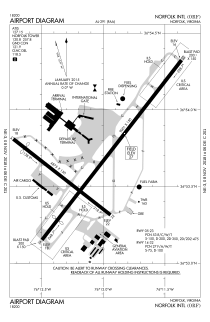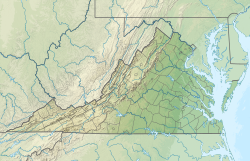Norfolk International Airport
Norfolk International Airport (IATA: ORF, ICAO: KORF, FAA LID: ORF) is a public airport in Norfolk, Virginia.[2] It is owned by the city of Norfolk. The Norfolk Airport Authority runs the airport. It is a part of the municipal government. The airport is used by the Hampton Roads metropolitan area of southeast Virginia. It is also used by the people of northeast North Carolina.
Norfolk International Airport | |||||||||||||||
|---|---|---|---|---|---|---|---|---|---|---|---|---|---|---|---|
 The Main Departures Building at ORF. | |||||||||||||||
| Summary | |||||||||||||||
| Airport type | Public | ||||||||||||||
| Owner | City of Norfolk | ||||||||||||||
| Operator | Norfolk Airport Authority | ||||||||||||||
| Serves | Hampton Roads, Northeast North Carolina | ||||||||||||||
| Location | Norfolk, Virginia, U.S. | ||||||||||||||
| Elevation AMSL | 27 ft / 8 m | ||||||||||||||
| Coordinates | 36°53′41″N 076°12′04″W / 36.89472°N 76.20111°W | ||||||||||||||
| Website | NorfolkAirport.com | ||||||||||||||
| Maps | |||||||||||||||
 Diagram | |||||||||||||||
| Runways | |||||||||||||||
| |||||||||||||||
| Statistics | |||||||||||||||
| |||||||||||||||
Norfolk International has almost 80 flights leave each day.[3] These flights to go large cities in the United States. The airport is the third-busiest airport in Virginia. It is the country's 66th largest airport in terms of people using it each year.[4] Over 3.5 million people used the airport in 2009.[5] In June 2011, Norfolk International had 311,000 passengers.[6]
Southwest Airlines, US Airways, Delta Air Lines and American Airlines are the main airlines that use the airport.
History
changeCommercial aviation began in the Norfolk area about 1926. Norfolk citizens flew commercially for the first time on the Mitten Line. It was run by Philadelphia Rapid Transit Air Service, Inc. Norfolk International Airport was built in 1938. It had a 3,500-foot (1,100 m) runway. The first terminal was built by 1940.
During World War II, Norfolk Municipal Airport became important to the war effort. The United States Army Air Corps took control of the airport between 1942–1947. They made the runway longer and built two other runways. This was done to deal with a much larger number of flights and larger aircraft. The Norfolk Fighter Wing was created in August 1942. It providing air defense for the Norfolk area. The 52d Fighter Group was put at the airport after the Pearl Harbor attack in December 1941. Many squadrons were at Norfolk Airport during the early years of the war. This ended at the end of July 1944.
The Army Air Corps gave control of the airport back to the city at the end of 1945. The amount of commercial travel grew quickly with two new airlines having regular flights. In 1948, Piedmont Airlines began flights. That same year, construction began for a larger, more modern terminal building.
In 1950, control of the airport was turned over to the newly created Norfolk Port and Industrial Authority (NPIA). At that time, Norfolk Municipal Airport was one of the busiest in the nation. In 1951, the new terminal was opened.
In the 1960s, the change from propeller aircraft to jets took place. Norfolk Municipal Airport made changes with longer and stronger runways and taxiway facilities. Because of this, in 1968, the airport was the air transportation center for the entire Hampton Roads area. It name was changed to Norfolk Regional Airport. To be ready for large growth over the next three decades, NPIA created a plan that would grow the airport as it entered into the 21st century.
In 1974, the airport opened its new terminal. More land was bought so that the airport could be made larger. In 1976, the airport's name was changed to Norfolk International Airport. Federal customs facilities were added. New buildings were built to hold the fire station, maintenance depot and ATC tower. One of the problems the airport faced as it grew was dealt with by the nearby Botanical Garden. It created an buffer area between the airport and the city around it. Norfolk International Airport was surrounded by year-round beauty. It was a national role model for dealing with growing air facilities and an ecological sanctuary.
In the 1980s, many changes took place. A new general aviation facility opened. A new air cargo terminal was built as well. More areas for parking were also added. Even the name of the controlling body changed in 1988 - from Norfolk Port and Industrial Authority to Norfolk Airport Authority.
In the 1990s the air cargo terminal and parking facilities were made bigger. In 1991, Norfolk International made the concourses larger. This added 10 additional gates. It now had a total of 24 gates. A new fire station and new FAA air traffic control tower facility were also built.
Facilities and aircraft
changeNorfolk International Airport covers area of 1,300 acres (5.3 km2). The airfield has a main runway (5-23) which is 9,000 by 150 feet (2,743 m × 46 m). Is also has a crosswind runway (14-32) which is 4,876 by 150 feet (1,486 m × 46 m).[2] These let almost all commercial aircraft types use the airfield.
The airport plans to destroy the crosswind runway and build a second runway parallel to the main runway 5-23.
In 2006, the airport had 128,715 aircraft operations. It had an average of 352 per day. The breakdown of the types of flights was 44% scheduled commercial, 33% general aviation, 16% air taxi and 8% military. At that time there were 106 aircraft based at this airport. About half of these (51%) were single-engine planes. Of the rest, 30% were multi-engine, 17% jet aircraft and 2% were helicopter.[2]
FAA Control Tower
changeThe FAA Norfolk Air Traffic Control Tower was built in 1995. It is 134 feet (41 m) high. The Federal Aviation Administration is in control of the Norfolk Tower. It deals with about 1,100 aircraft each day.
Cargo
changeNorfolk International Airport (NIA) has one of the most modern and efficient air cargo facilities in the state of Virginia. About 70 million pounds of air cargo are moved in and out of the Airport each year.[7] The airport is used by many companies with airlines that only move cargo. These include Airborne Express, FedEx, United Parcel Service and the U.S. Postal Service. NIA's two air cargo terminals have 88,000 square feet (8,200 m2) of space. An adjacent aircraft ramp gives access from planes to the warehouses.
Passenger services
changeGround transportation
changeThere are no bus services to and from Norfolk International Airport. The closest bus stop is 1.5 miles (2.4 km) away.[8]
All ground transportation services are in the arrivals terminal. There are several rental car companies in the terminal and Taxis are usually found at the main entrance.
Parking
changeA nine-floor long-term parking garage is next to the arrivals terminal. It was opened in July 2002. The garage has 2,800 parking spaces.
References
change- ↑ "Press Room - Norfolk International Airport". www.norfolkairport.com.
- ↑ 2.0 2.1 2.2 2.3 FAA Airport Master Record for ORF (Form 5010 PDF). Federal Aviation Administration. effective November 8, 2018.
- ↑ "8 Non-stop Flights Added" (PDF). Feb 16, 2010.[permanent dead link]
- ↑ [1][permanent dead link]
- ↑ "Norfolk Airport Statistics" (PDF). Archived from the original (PDF) on 2007-10-25. Retrieved 2012-01-20.
- ↑ "Norfolk airport passenger traffic dips in June". Archived from the original on 2016-03-07. Retrieved 2017-08-31.
- ↑ "Press Room". Norfolk International Airport. Archived from the original on 2012-01-17. Retrieved 2013-05-10.
- ↑ Distance from airport to intersection of Route 165 & Route 247
Other websites
change- [2][permanent dead link] Airport tracker
- [3][permanent dead link] (master plan website)
- Norfolk International Airport (official site)
- Live webcam image from WAVY-TV Archived 2012-02-13 at the Wayback Machine
- FAA Airport Diagram (PDF), effective 15 December 2011
- Resources for this airport:
- AirNav airport information for KORF
- ASN accident history for ORF
- FlightAware airport information and live flight tracker
- NOAA/NWS latest weather observations
- SkyVector aeronautical chart for KORF
- FAA current ORF delay information
Norfolk Airport Pictures
change- http://www.outerbankschamber.com/images/sign.gif Archived 2008-06-27 at the Wayback Machine - Main terminal building and pedestrian bridge
- http://www.howardmodels.com/Architectural-Scale-Models/Norfolk-Airport/pic4.jpg
- http://www.pbase.com/airlinerphotos/aerials_airports - Aerial picture

